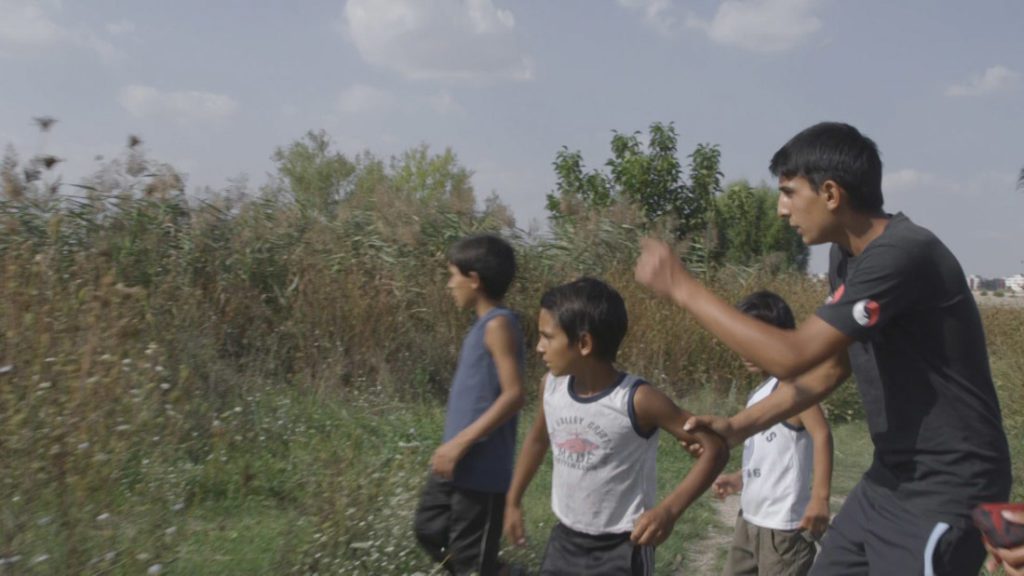-
Acasa, My Home
malni--towards the ocean, towards the shore
Two documentaries about family, Acasa, My Home and malni—towards the ocean, towards the shore take closer looks at how we decide to live our lives and how we deal with our past.
Both Acasa, My Home and malni–towards the ocean, towards the shore were seen at Sundance 2020. Check out all of our coverage from the festival.
Acasa, My Home
If you are judging documentaries by the amount of close access to their subjects, Acasa, My Home shoots to the top of the list. Following a large family in Romania, Radu Ciorniciuc’s film is an intimate portrait of transplantation, moving people outside of their habitats. Living in one of Eastern Europe’s largest urban wildernesses, the Enache family, all 11 of them, are forced to move out of the forest and into the neighboring city. After subsisting on fish caught in the river, minimal supplies in a small shack, and the big loves of a family bonded through necessity, the Enache’s move into a city environment represents the difficulties you find when you’re forced into change.
Chronicling the family’s time before they move through the next few years including the kids’ education and childhoods, Ciorniciuc’s film is always personal. The director looks to be living with these people wherever they are, spending time with them 24 hours a day, seven days a week. While watching Acasa, My Home, you feel an odd, immoral sense of spying on this family, as if you’re invading upon their private space. As the family fights, you sit alongside the youngest children just taking in the lives of these people, completely unable to help or hurt them in any way. You’re only there to listen and try to understand the pains these people are going through, how their personal gentrification leads to unwanted frustrations and anger from the various members of the family.
The subjects themselves remain fascinating through the 86-minute runtime, which breezes along. Though on the shorter side of feature films, it never rushes to the next scene or the next fight. Ciorniciuc is content to be with these people in the quiet moments as well as the loud ones, taking a special interest in the oldest son, one of the main providers for his siblings. His growth and subsequent detachment from the family serve as one of the harshest consequences of this change in home, with the father becoming sicker and sicker as well. The characters could have been written for a fiction story, and I couldn’t help myself thinking about the family from 2018’s Shoplifters. Though quite different circumstances surround both families, they are seen by others as simply surviving, while they see themselves as living, a dichotomy represented in how society forces them to exist in a specific way.
If you’re looking for a documentary to make you ponder the way in which this world works, and how we force others to see from our own point of view, Acasa, My Home has a powerful, affecting presence. Its intimacy along with careful filmmaking by director Ciorniciuc makes it a documentary with worldly resonance.
malni–towards the ocean, towards the shore
Existing somewhere in-between documentary and experimental nature feature, malni–towards the ocean, towards the shore is best seen with maximum focus. Sky Hopinka’s feature directorial debut looks at two indigenous people in the Pacific Northwest (PNW). Looking at the lives of Sweetwater Sahme and Jordan Mercier, Hopinka’s film follows them as they process their own lives, deaths, and everyday interactions.
A rather slow-paced and meditative film, malni—towards the ocean, towards the shore combines these people’s stories with gorgeous images of the PNW. Hopinka isn’t afraid to let the camera sit on the ocean for two minutes, to allow his subjects to be out of focus, and to have the brooding score be all we hear. A speaker of the indigenous language chinuk wawa of the PNW himself, the director explores themes of nativism and the pride, or lack thereof, surrounding these homelands throughout the country.
The documentary works best when we hear the words of the subjects voiced over striking images of these lands. When subjects talk about the length of their hair, speaking their native language, or singing the songs of their ancestors, the film bursts with life and importance. More than anything, we rarely see these stories being told on the big screen, and these subjects hardly receive screen-time in the form of documentary or fiction. Hopinka has made a film that deserves to be spread amongst all people, giving a more insightful look into indigenous language and culture.
The language of the film fluctuates between native languages and English, spoken by both persons of interest. When subjects speak English though, native language subtitles flash on the screen. It’s a small touch that goes a long, long way, but it is more representative of the film as a whole: careful crafting of quick vignettes of these people’s lives. Hopinka clearly has a love for these people, these lands, and these cultures, which makes the experimental documentary that much more enjoyable.
The film doesn’t move with any speed or specified purpose, though. The narratives are scattered, and the runtime still feels 15 minutes too long. The voiceover and nature images lose their luster after the first hour, and the storytelling lacks bite and continued interest.
If malni—towards the ocean, towards the shore is Hopinka’s first effort though, his second, third, and fourth stabs at filmmaking will only continue to rise in magic and beauty.



